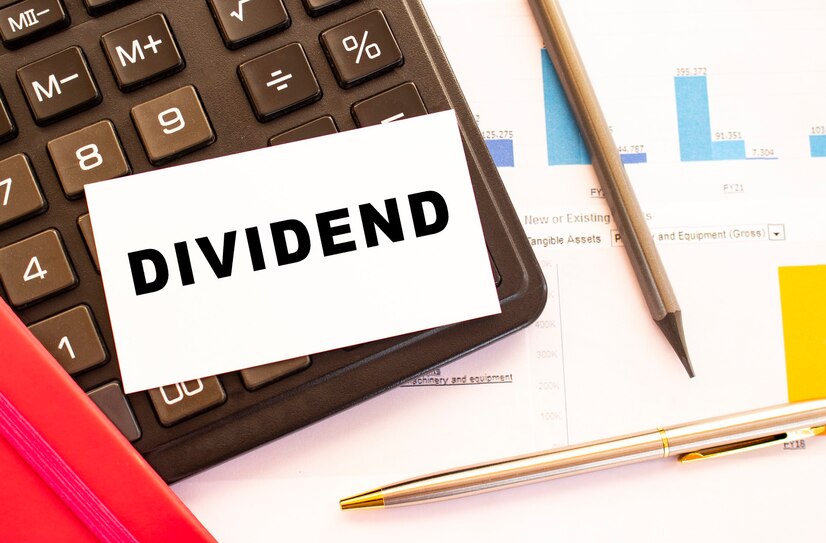Dividends are your regular payment earned as a s profit by investors who own the company's stock. Though, when you consider investing in the stock market, remember not all stocks pay dividends to investors. When a company makes share profits it is paid to shareholders in the form of dividends, and usually it is paid regularly. Sounds interesting? We will discuss dividend finance and all the factors leading to successful earning through dividends stocks.
If you are interested in investing in dividends, then you will have to choose dividend stocks. Owning a dividend stock and saving investors from current high inflation circumstances. Companies that increase dividend payments every year are considered less volatile compared to the broader market.
Some other companies would respond to inflation by raising their dividend payments. In the end, having an income through dividends aids in maximizing steady stock returns for investors.
Let us walk you through the process and factors involved in achieving dividend finance and solve your concerns like How are dividends paid? What are dividend stocks? Or How dividends work?
- What are Dividend stocks?
- Types of Dividend Finance
- In and Outs of Dividends
- What are the high-paying Dividend Companies?
- Understandings varied dates with Dividends
- Why should I invest in dividends?
- How do Dividends impact stock prices?
- How Dividends work?
- Are Dividend earnings taxed?
- How can I assess Dividends?
- How can I purchase dividend-paying investments?
- Bottom Line
- What are Dividend Stocks?
- Types of Dividend Finance
- In and Outs of Dividends
- What are the High-Paying Dividend Companies?
- Understandings Varied Dates with Dividends
- Why Should I Invest in Dividends?
- How do Dividends Work?
- Are Dividend Earnings Taxed?
- How can I Assess Dividends?
- How can I Purchase Dividend-Paying Investments?
- Bottom Line
- Frequently Asked Questions
What are Dividend Stocks?
Before we delve deeper into the process of distribution of dividends and methods to earn dividend finance, let us understand what are dividend stocks.
As we discussed above, a dividend is the distribution of the company’s earnings offered to their shareholders, and the decision for the dividend yields and payments are made by the company's state of the board. Additionally, dividends are often paid quarterly and you can expect payment of dividend stocks through cash or a source of reinvestment in other additional stocks.
The yield of a dividend is determined per share and often termed or offered as a dividend or price as per percentage of a company’s share price like 2.5%. The shareholders of high-dividend paying companies are eligible to receive dividends until and unless they own the stock before the announced ex-dividend date.
Key Factors about Dividend Finance to Remember
- A dividend stock provides the distribution of corporate earnings to eligible investors.
- Many companies don't offer you a dividend, instead retain the corporate earnings to be invested in the company.
- Earnings for dividends can serve as a regular income for investors, which can be a savior during inflation
- Evaluate your opportunity to earn from dividends by analyzing the company's dividend per share, dividend yield, and payout ratio.
Types of Dividend Finance
If you wish to determine how companies pay out dividends to their investors, you must be well-versed in the types of dividends. Usually, dividends are distributed based on common stocks, however, companies may choose their payment method based on the types. Join us to explore these types to acquire dividend finance.
Stock Dividends
Apart from offering cash payments, a few companies may provide dividend payments in the form of additional shares of the stock.
Cash Dividends
Cash dividends are one of the most common and most preferred forms of dividend payment. Companies usually provide cash payments to the eligible shareholder directly in their broker’s account.
Special Dividends
This type of dividend paid on all shares of a company’s common stocks doesn’t recur like a regular dividend payout. A company would issue a special dividend to distribute the profits generated to investors over the years, and it has no immediate need in the company.
Dividend Reinvestment Programs (DRIPs)
With DRIP investors can reinvest in any dividend that is received back in the form of the company's stock, usually at a discount. Though opting for this program is not mandatory, investors can choose to receive continuous cash payments.
Preferred Payments
Preferred dividends are less like stocks and more like a bond. Preferred dividends are usually paid every quarter to their investors. However, unlike common stock, these types of dividend payouts are fixed.
In and Outs of Dividends
The rewards of dividends can be motivating factors to invest in a company that offers a higher yield for buying dividends, though you must have a complete overview of this investment instrument before you begin your journey in the stock market.
Shareholders have voting rights regarding dividends, hence it must be approved by shareholders. While cash payments are a common payment type, dividends can be issued as shares of the stock. Additionally, funds like Mutual funds or Exchange-traded funds (ETFs) also pay dividends.
Distributions of dividends are paid to investors for their investments in a company’s equity, and these rewards are generated from a company’s net profit. Though companies can decide to retain the profits with them to fulfill ongoing or future business operations, the remaining shares are allocated to investors as a form of dividend.
However, companies may continue paying distributions of dividends even when they don't make suitable profits. Because they want to maintain a solid record of distributions over the years.
Dividend Payment Schedule
Additionally, the board of directors of a particular company can choose to issue dividends on various time frames, and with different payment rates. Though, dividends are paid on a scheduled frequency like monthly, quarterly, or at the time annually. For instance, Walmart (WMT) and Unilever (UL) distribute dividends regularly every quarter.
Companies can also issue non-recurring special dividends, one of the dividend types that we discussed above. These special dividends can be issued individually or along with scheduled dividends. For instance, United Bancorp Inc. announced 15 cents per share as a special dividend in February 2023.
Read Also:- A Step-by-Step Process to Buy Bonds
What are the High-Paying Dividend Companies?
The larger companies that have predictable profits are often considered the best dividend payers. We are listing below a few industries that are known for maintaining a regular track on making regular distributions of dividends.
- Oil and gas
- Banks and financial
- Basic materials
- Utilities
- Healthcare and Pharmaceuticals
The companies that are structured as master limited partnerships (MLPs) and real estate investment trusts (REITs) require specific distribution to payout to shareholders. Funds can issue regular dividends payment as mentioned in the investment objectives.
Startups, especially in the sector of technology and biotech, may not be able to pay regular dividends to their shareholders as this company is still in the early development stage. Hence, companies may decide to retain the profits for research and development, expanding business, or other vital business operational activities.
Understandings Varied Dates with Dividends
Investors need to be aware of dividend dates to plan out their investments and set correct expectations of receiving their regular returns. Usually, dividends follow a chronological set of events. Also, these dates will determine whether shareholders qualify for receiving dividend payouts.
Announce Date
Usually, dividends are announced by the management of the company on announced dates, also known as declaration dates. These dates must be approved by shareholders before they receive payment from dividends.
Ex-dividend Date
When the eligibility for dividend expires is referred to as the ex-dividend date. If a dividend has an expiry date of May 10, then the shareholders who buy on that date or after that date would not be qualified for receiving the payouts. However, shareholders who buy dividends before the expiry date even 1 or 2 business days before the date still would receive payment.
Record Date
The record date is when the cut-off of the dividend is declared. The cut-off is established by companies to decide which shareholders qualify on receiving payouts or distributions.
Date for Payment
On the payment date, companies would credit payouts or distributions to investors’ accounts.
Why Should I Invest in Dividends?
Stocks that pay dividends can be an ideal source of stable and growing income for investors.
Like any investment instrument, dividends on common stocks are not guaranteed. Though dividend finances tend to be paid by established companies that do not require money to reinvest in their business, hence there is a high chance that you would receive dividend payments regularly.
Additionally, dividends are considered an indicator of the well-being of any company. Once a company establishes or raises dividends, investors would expect that company would maintain their regular dividend payouts even in the downfalls. Often investors have a mindset of devaluing a stock when they assume the dividend is likely to get reduced, which leads to lowering the stock price.
As per the research Fidelity, in times of inflation stocks that increased their dividends were observed outperforming the broader market on average.
Examples of a few USA Dividend Paying Companies
The most reliable companies in American companies have a robust record of growing dividends, with no cuts for decades. Let us have a look at the companies that have a continuous record of growing dividends.
- American Electrical power
- Principal financial group
- Target
- Exxon
- Apple
- CVS
A list of S&P 500 stock companies like Dividend Aristocrats have consistently increased their dividend every year for 25 years. In comparison, high-growth companies from tech or biotech sectors rarely pay dividends as they need money to invest in their business to complete business operations or business operations.
For investors who do not wish to research and select individual stocks, then exploring mutual funds or Dividend exchange-traded funds can be an ideal option for you. These funds hold many dividend stocks in one investment and are available for a range of budgets.
How do Dividends Work?
Are you wondering how dividends work or how are dividends paid? Let’s assume you have 30 shares and the company pays $2 for each cash dividend, which means you will receive $60 per year. Let's see how this works.
- To begin with, a company earns suitable profits
- The next step involves the approval of the company's board of directors to share the profits earned in the form of dividends, and then it is distributed per stock share. Most US companies paid dividends on a schedule of monthly, quarterly, or annually.
- The company would announce the dates for dividend payouts with the amount and ex-dividend date. Investors must buy the dividend at least 2 days before the payment, or else you won't be eligible for the payment.
- Finally, the company payouts the dividend to shareholders.
Are Dividend Earnings Taxed?
All types of dividend finance are subject to taxation. Dividends that are paid by US companies or US-based companies to shareholders who have at least owned the stocks for 60 are qualified dividends and are subject to capital gains tax rates. And, all other taxes are taxable as per regular income tax rates.
How can I Assess Dividends?
If you are motivated to invest in dividends to acquire your financial independence, then you must know how to evaluate varied dividend options. Investors can use multiple methods to discover more about a company’s dividend and compare between ideal alternatives.
Dividend per share
There are a few companies that increase dividends year after year are sought together. The dividend per share calculation method determines the amount of the dividend that is distributed by a certain company for each share of the stock for a specific time. Keeping track of DPS will allow investors to analyze which companies can increase or grow dividends over the years.
Dividend yield
Financial websites or brokerage online provide reports on a company's dividend yield. This measures the company’s annual dividends divided by the stock price for a specific time.
This method equals the current field and enables a more accurate comparison between the dividend stocks. A $10 stock paying $0.10 quarterly will have the same yield as a $100 stock paying $1 quarterly, the yield in these cases is 4%.
However, yield and stock are inversely connected. When one rises, the other would fall so there are two methods for dividend stock yield to rise.
The company could raise dividends: A $100 stock with a $4 dividend may observe a 10% increase in dividend by raising annual payments to $4.40 per share. If the stock price remains the same, then the yield would be 4.4%.
The dividend remains the same, the stock price rises: A $100 stock with a $4 dividend may decline to $90 per share. Though, with the $4 dividend, the yield would remain at 4.4%.
Dividend Payout Ratio
One of the easiest ways to calculate a dividend’s safety includes - checking the payout ratio, or the portion of their net income that goes for paying dividends.
For instance, if a company pays 100 or more from its income, then dividends can be in trouble because during a downfall a company can lower the dividend payouts. Usually, investors would look for payout ratios of 80% or lower. Likely a stock dividend yield, even if the payout ratios are listed on financial websites or online brokerage sites.
Read Also:- Navigating Stock Market Working Secrets To Your Investment Journey
How can I Purchase Dividend-Paying Investments?
Investors who are looking to buy dividend-paying stocks can explore mutual funds, stocks, and exchange-traded funds (ETFs). Additionally, the dividend discount model can help you choose the right stock investments. However, these methods would highly rely on estimated future dividend streams to value shares.
You can consider using the dividend yield factor to compare varied stocks based on the payment performance of dividends. Also, it helps in calculating dividends in terms of the percentage of the current stock market price of the company’s shares.
Additionally, the dividend rates can be quoted as a dollar amount for each share received as a dividend per share. With stock dividend yield, another performance measuring indicator includes total return factors, helpful for analyzing the return generated on a particular investment. This method aids in measuring interest, dividends, increased share price, and other capital gains.
Bottom Line
While dividends indicate that a company has stable cash flow, and generates great profits it also offers investors a source to gain recurring income. Dividend finance also helps in obtaining insights into a company's value and growth. There are a few countries that offer preferential tax with dividends which means dividends are considered tax-free income.
Frequently Asked Questions
Depending on the dividend type, payout methods will differ however one of the common methods for distributing dividends includes - a company offering cash payments on a per-share basis directly to the shareholder’s account. While others will offer additional shares of the stock or will provide a program to reinvest your payments in other dividend stocks.
There are chances that companies may suspend or reduce dividend payouts in times of financial downfall or when they decide to allocate funds elsewhere for business growth.







